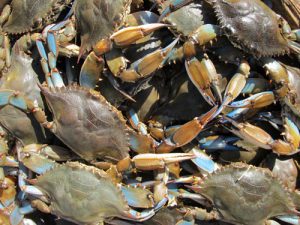
The Maryland Department of Natural Resources (DNR) and the Virginia Institute of Marine Science (VIMS) recently announced the results of the 2021 Blue Crab Winter Dredge Survey. The annual cooperative survey estimates the number of blue crabs in the Chesapeake Bay.
The 2021 results showed that the spawning age female abundance increased from 141 million spawning age female crabs in 2020 to 158 million spawning age female crabs. This year’s survey estimate is above the long-term average of 126 million spawning age female crabs.
Scientists and managers use target and threshold abundance estimates to establish a healthy level of spawning age female abundance based on available historical information.
Recently scientists reevaluated the healthy range of spawning age female abundance through a stock assessment analysis and updated the target and threshold spawning age female abundance estimates.
This year, the number of spawning age females estimated to be in the Bay is well above the updated threshold of 72.5 million, but slightly below the updated target of 196 million.
The total abundance of blue crab in the Chesapeake Bay in 2021 was 282 million crabs, a below average total for the 32 years of survey results. Total crab abundance is down due to low counts of juvenile and adult male blue crabs. The number of juvenile crabs in 2021 was 86 million, which is the lowest recorded juvenile abundance since the start of the survey. Additionally, the results showed there were 39 million adult male crabs, below the long-term average of 77 million.
Although the specific cause of this year’s low abundance of age-0 crabs cannot be identified, large variations in annual juvenile recruitment to the Chesapeake Bay are normal for blue crabs. After spawning at the mouth of the Chesapeake Bay, young crabs develop in the ocean over the continental shelf and rely on winds and currents to be transported back into the Bay where they settle and grow. Therefore, annual juvenile abundance is largely driven by environmental factors.
The Chesapeake Bay Stock Assessment Committee will review the survey results and provide their scientific advice for management during their May meeting. Following their advice, DNR will begin discussions with the Blue Crab Industry Advisory Committee to provide guidance concerning the course of action for 2021 that promotes the health of the Chesapeake Bay blue crab population and its fisheries.
Maryland, Virginia, and the Potomac River Fisheries Commission cooperate to conserve more than 70 million adult female crabs annually.
Reduced numbers of crabs can affect wildlife as well as human activities. Juvenile blue crabs are an important forage food for fish, birds, and other wildlife. Throughout the Chesapeake Bay, the blue fishery has considerable economic and cultural impacts.
The Winter Dredge Survey has been conducted cooperatively by the Maryland Department of Natural Resources (DNR) and the Virginia Institute of Marine Science (VIMS) since 1990. The results are reviewed annually in an effort to have consistent management efforts across the jurisdictions.
Throughout the survey, biologists use dredge equipment to capture, measure, record, and release blue crabs at 1,500 sites throughout the Chesapeake Bay from December through March.
sources: Maryland Department of Natural Resources, Virginia Institute of Marine Science
Leave a Reply
You must be logged in to post a comment.